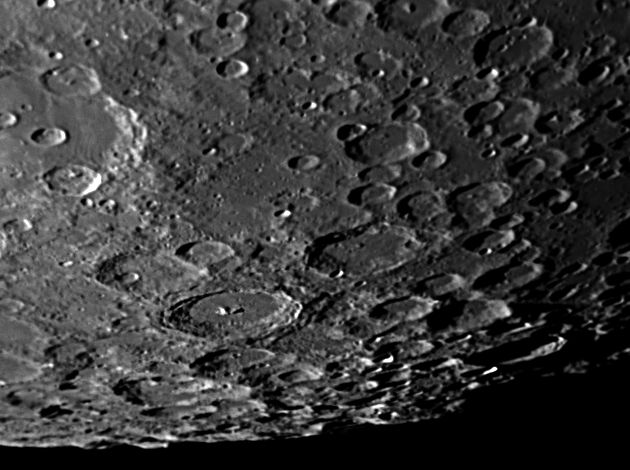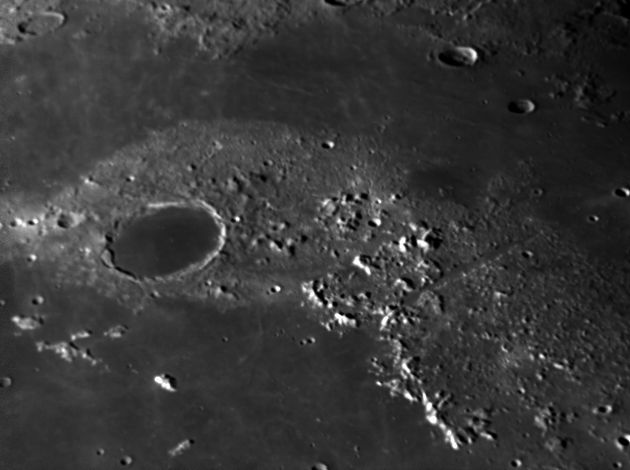

I've bought a DMK 21AF04 camera. This is a 640×480 pixel monochrome camera which is able to download uncompressed images at 60 per second. This is particularly useful for imaging the Moon when 3600 images can be captured in a minute and only the very few really good ones used to make the final image. The day after it arrived we had an unexpected clear night so I was able to install it in my new observsatory, so these pictures represent first light for both the camera and the observatoy. Both were necessary to get these pictures because I would never have dragged the 'scope outside at 4 o'clock in the morning. I had left the telescope in its home position (0° HA and dec), so all I had to do was turn it on and tell it to go to the Moon and there it was in the fov. All in all I am quite pleased with these results, especially as I am not experienced with this camera and it was all set up rather hurriedly at 4 o'clock in the morning. The processing in Registax was fairly crude as well, in that I did not generate a reference frame and used only frames with a quality greater than 90%. The camera data is simply what the software tells me, and I have little idea what a gain of 564, for example, actually means (nor can I remember what it goes up to...), but it is about half way. The camera seems to come with its own selection of exposure times, some of which are very odd indeed; the figure of 1/91 sec above is not a typing error.

The Moon was at 77% illumination, about 2 days after Full Moon, so the south seemed a good place to start. This picture of Moretus and its surroundings was made by capturing 3454 frames and stacking the best 79 of them in Registax4.
Date and Time: 7th November 2009 04:34 UT
Camera: DMK 21AF04
Telescope: LX200 at prime focus and IR-pass filter (>685nm)
Capture: IC Capture. Gamma 10 (the lowest), exposure 1/91", gain 564, 3454 frames @ 60 fps
Processing: Registax. 79 frames stacked. Wavelets 1, 2 = 5, gamma 0.7

I was a bit concerned that the lowest gamma on the camera seemed to be quite high (increasing it really did not help), so I wanted to image a mare area where low gamma tends to work out best. This area of the Montes Alpes seemd like a nice choise, having some rugged terrain as well. As with the picture above, I had to reduce the gamma in Registax to get a picture I liked. As you will notice, I used the same gamma in Registax in both pictures. I think I have over-exposed this picture slightly; the washed out highlights are not the result of processing.
Date and Time: 7th November 2009 04:26 UT
Camera: DMK 21AF04
Telescope: LX200 at prime focus and IR-pass filter (>685nm)
Capture: IC Capture. Gamma 10 (the lowest), exposure 1/91", gain 564, 3437 frames @ 60 fps
Processing: Registax. 202 frames stacked. Wavelets 1, 2 = 5, gamma 0.7
Home Back to Equipment Back to the Moon